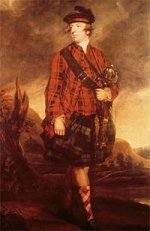|
 John Murray, Fourth Earl of Dunmore, is best known for his role as Royal Governor of Virginia during the tense and chaotic years leading up to the American Revolution. He succeeded his father, the third Earl of Dunmore, in 1756 and sat in the House of Lords as a Scottish Peer. He was appointed governor of the Province of New York in 1770 but one year later left to serve as governor of the Virginia Colony. He remained in that position until July 1776, when he returned to Great Britain. In an effort to strengthen Virginia’s claims to western land, he engaged in a series of campaigns against the Indians. He may have devised the campaigns as a way to weaken the Virginia military structure in favor of the Loyalist cause, since at the time rebellion was fomenting in the colonies. John Murray, Fourth Earl of Dunmore, is best known for his role as Royal Governor of Virginia during the tense and chaotic years leading up to the American Revolution. He succeeded his father, the third Earl of Dunmore, in 1756 and sat in the House of Lords as a Scottish Peer. He was appointed governor of the Province of New York in 1770 but one year later left to serve as governor of the Virginia Colony. He remained in that position until July 1776, when he returned to Great Britain. In an effort to strengthen Virginia’s claims to western land, he engaged in a series of campaigns against the Indians. He may have devised the campaigns as a way to weaken the Virginia military structure in favor of the Loyalist cause, since at the time rebellion was fomenting in the colonies.
Dunmore did not have a good working relationship with the Colonial Virginia Assembly. His controversial rule reached a peak in November 1775, when he offered freedom to African slaves who joined his Loyalist Army. Though this was the first mass emancipation of American slaves, only around one percent (approximately 1,000) actually joined Dunmore. Despite these relatively small numbers, fear and anxiety spread in the white population of Virginia, driving even more to support the idea of revolution. Dunmore’s troops successfully engaged in battle at Kemp’s Landing, but were soundly defeated at the Battle of Great Bridge in December 1775. Following that defeat he loaded his troops and a number of remaining Virginia Loyalists onto British ships. On Jan 1, 1776, Dunmore ordered his troops to set fire to waterfront buildings in Norfolk, Virginia, as patriots on shore were firing at his ships. This strategy, however, backfired, when the patriots burned the entire city. Dunmore retreated to New York, dispersing his remaining troops and supporters to points south.
Following the American Revolution, Dunmore served as Governor of the Bahamas, and he was responsible for most of the fort building in and around Nassau. At least one fort was nicknamed "Dunmore's Folly" for the expense involved for a fortification in an arena where attack upon the Bahamas was considered highly unlikely. He married Lady Charlotte, daughter of the Sixth Earl of Galloway, and their daughter later became the daughter-in-law of King George III. Upon his death in 1809 Dunmore was succeeded by his eldest son, George.
Image: The 4th Earl of Dunmore, contemporary portrait.
|